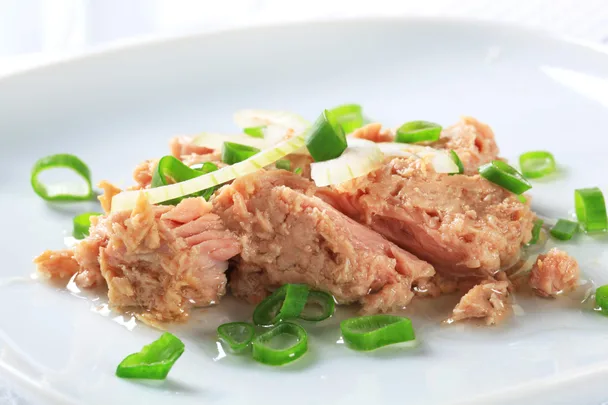How many calories in a tin of tuna? 100g of tuna without any added salt will have about 116 Kcal. The calorie count will vary from tin to tin, depending on whether the tuna was packed in oil, brine, or water. Extra seasonings or ingredients will increase a can of tuna’s calories but can add more nutrients.
RELATED: Herb Fish Cakes With Avocado Salsa Recipe
Canned tuna: nutritional facts and calories count
Despite coming in a can, tinned tuna is actually full of vitamins and minerals. But the nutritional value will depend on what it was packed with and how it’s prepped! 100g of tuna strained of water, without any salt, only has 116 Kcal.

Packing in oil will change the calorie count. 100g of Sirena Tuna with chilli in oil has 161 kcal when strained, but 100g of Sirena Tuna In Springwater has only 100 Kcal.
Brands vary in calorie count too. Greenseas Tuna Chunks in Springwater has 112 Kcal for every 100g of the drained tuna. The Sweet Chilli variant has a much higher 170 Kcal for every 100g. John West Tuna Chunks In Brine has 113 Kcal for every drained 100g, but the Tuna Steak In Sunflower Oil has 180 Kcal for every drained 100g.
Is canned tuna good for your health?
Canned tuna has plenty of minerals and is a good source of omega-3. It’s recommended that we eat more oily fish in our diets, as oily fish has more omega-3 fatty acids than other kinds. The extra omega-3 can help brain functions and reduce inflammation. It also improves cardiovascular health.
Canned tuna is also packed with protein, which you need to recover from workouts and maintain bone density. Rich in vitamin A, selenium, magnesium and other nutrients crucial to our health, canned tuna can be an inexpensive way to get some valuable nutrients in your diet.

But if you’re keeping an eye on your calories, watch out for what it’s packed in. Tuna packed in oil can have, on average, up to a whopping 340 Kcal per 100g, which is triple the calories compared to the same amount packed in water! Check the sodium content of your favourite tins too. A low-sodium variant will give you all of the nutrients and none of the salt bloat.
Cooked, raw, or canned? Comparing tuna calories and nutrition
Tuna that’s canned in water and strained out will have only 116 Kcal for every 100g, which is pretty low despite having 25.5g of protein. It’s also lower in saturated fat: canned tuna has only 0.2g of it in every 100g. However, it can get quite high in sodium even without added salt, as every 100g has 82 mg of sodium. One benefit of eating the canned stuff? Higher selenium, with 80.4 mcg per 100g.

For every 100g of fresh, raw bluefin tuna, you’ll be eating 144 Kcal, but it has a whopping 1,298mg of omega-3 compared to much lower numbers in canned tuna. Fresh tuna has slightly less protein, providing 23.3g of protein for every 100g, but because it has nothing added, it also has very low sodium at 39mg per 100g of fresh tuna. Out of the three forms, it has the highest amount of omega-3 and can also be a rich source of vitamin A!
There is 153 Kcal in 100g of cooked tuna, which is still pretty low! However, depending on how you prep it, it can have as much as 15% of your daily sodium intake, so lay off the salt if you love cooked tuna. It’s also low in saturated fat and has double the vitamin A in canned tuna, but it’s lower in omega-3 than raw tuna
No matter which form of tuna you choose to eat, it’s still an excellent source of protein, omega-3, magnesium and niacin, all of which are crucial to your health. It’s a healthier choice than many other proteins, so try incorporating more fatty fish like tuna into your meals!
Are there health risks to eating canned tuna?
Some experts have warned against possible high mercury levels in tuna. The US FDA recommends that adults can safely eat around 85g of canned tuna, depending on the fish variety, around once to twice a week. They have dietary guidelines for how much to consume based on your body weight.

If you’re pregnant or breastfeeding, it’s recommended that you avoid canned tuna just to stay on the safe side. Check the tuna variety used by your favourite tin if you can. Light tuna has the least amount of mercury, so it’s still one of their best choices as a fish to include in your weekly diet.
Some tuna dishes are healthier than others!
Though canned tuna is healthy, you also need to watch how you prep it. If you like sushi, the average tuna roll has only 184 Kcal, making it a good source of carbs and protein. A tuna sandwich made with two slices of toasted white bread and 100g of tuna will have around 280 Kcal, and that number can go up depending on any added condiments or vegetables.
Tuna salads can vary wildly in calorie count depending on whether they’re made with mayo, and if there’s any added salt. Tuna salad made with tuna packed in oil and regular mayo can have up to 380 Kcal for every 100g, so if you’re watching your waistline, lower the calorie count by choosing light tuna in springwater and ditch the regular mayo for a fat-free dressing.
Canned tuna is a great way to add protein to your diet
Despite coming in a can, tinned tuna is a cheap and easy way to add much-needed protein and fatty acids into your diet. Just watch how much you consume in a week to avoid exceeding safe mercury levels and you can get all the beneficial nutrients of this fatty fish. When packed in light ingredients and kept free of rich dressings, tuna is a waistline-friendly food!
RELATED: Charred Broccoli With Tuna Mayo And Anchovy Dust
 Getty
Getty









